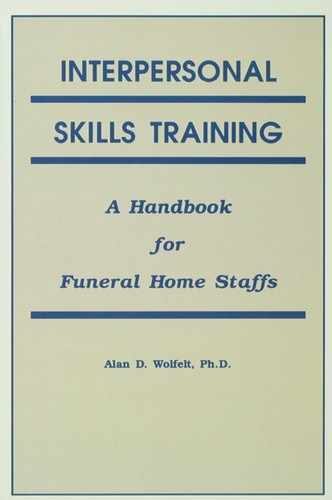SKILL SEVEN: REFLECTING FEELINGS
a. Reflecting feelings is when you express in fresh words the essential feelings, stated or strongly implied, of the person.
b. Expresses in fewer and different words the essential feelings that have been expressed.
2. IDENTIFY PURPOSES FOR USING THE SKILL
a. To communicate an understanding of what the person is feeling.
b. To communicate to the person that “I am hearing you,” “I am with you,” and “I am trying to learn from you—what you are feeling.”
c. To help the person bring vaguely expressed feelings into clearer awareness.
d. To understand, as a helping funeral director, what the person is experiencing.
3. ENHANCE UNDERSTANDING OF REFLECTING FEELINGS
Working in funeral service means working with people who experience a wide range of feelings. Having sensitivity to whatever those feelings are is essential to successfully serving the bereaved family. During times of grief, emotional states override cognitive thought processes. This emotional overflow is signified by such phrases as “overwhelmed with grief.”
Any effective interpersonal relationship requires the ability to be perceptive of what someone else feels. Emotional responses to others often determine whether we find them helpful, particularly during times of distress.
Bereaved persons vary in their emotional expressions. One person may openly express explosive emotions, confusion, or relief, while another may be unexpressive, numb, or in total shock. The helping funeral director must learn how to be respectful of whatever the person might feel.
Conveying an accurate understanding of what the bereaved person feels requires a desire to understand. Obviously, a desire to understand is a prerequisite to helping create a meaningful funeral service. Before learning how to reflect feelings, let’s review some general information about feelings:
a. feelings are neither good nor bad, they just are;
b. everyone has a right to his or her feelings;
c. feelings always make sense when considered in context of the person’s individual outlook on the world;
d. feelings are not dangerous (actions can potentially be dangerous); and
e. denying a feeling does not make it go away.
Having an awareness of the preceding information about feelings allows the helping funeral director to avoid any of the following actions:
a. denying the existence or importance of the person’s feelings,
b. trying to suppress the person’s expression of feelings, or
c. implying that something is wrong with the person’s feelings.
Obviously, any such actions not only would detract from the funeral director’s ability to help but also would give the message that something is wrong with the person being helped.
4. ILLUSTRATE THE USE OF REFLECTING FEELINGS
Bereaved Widow: “Right now, I really don’t know what to do.”
Funeral Director: “Sounds like you’re feeling confused.”
Bereaved Son: “The words that the pastor used during the service had so much meaning and purpose for me.”
Funeral Director: “When you think about the message the pastor gave, you feel comfort.”
Bereaved Widower: “She had been ill for so long. It’s been so hard on everyone. I’m just glad she’s out of her pain.”
Funeral Director: “Sounds as if you feel relieved she doesn’t have to go through all that anymore.”
a. Those persons you are helping will view you as one who understands what they are experiencing.
b. The person you are helping will be able to identify and express feelings more effectively.
c. The person you are helping will be encouraged to continue verbalizing thoughts and feelings.
When you, the helping funeral director, focus on how someone feels, you are responding in a helpful manner. By doing so, you are accomplishing one or more of the following objectives:
a. showing the person that you understand what he or she is experiencing;
b. supporting his or her feelings and, thus, supporting him or her;
c. helping the person focus in on his or her feelings;
d. giving the person the message that you accept his or her feelings.
Trainer will do any additional role-play modeling to enhance the ease of learning for participants.
GROUP REHEARSAL WITH TRAINER REFLECTING FEELINGS
Directions
The trainer will talk to the group about any topic. The task is for everyone to listen and when a natural break occurs anyone can offer to reflect a feeling.
This will allow everyone to practice in the group setting in a non-threatening environment. The trainer will provide immediate feedback on the reflecting of feelings and make any suggestions for improvement. This activity also allows participants to learn that a variety of ways exist to reflect feelings appropriately. Special attention will be given to different ways to lead into reflecting feelings. Participants will be encouraged to ask follow-up questions and clarify any misunderstandings related to this skill.
TRIAD BREAK-OUT REHEARSAL REFLECTING FEELINGS
Directions
Work in triads. One person (speaker) should talk freely for five minutes about any topic of interest. (Be certain to talk about something that generates feelings in you.) The second person (helper-listener) to whom he or she is speaking will concentrate on using the skill of reflecting feelings. The third person will be available to provide follow-up feedback on the appropriateness of the leading statements.
Each member of the triad will rotate through each of the three roles: speaker, helper-listener, and observer. The trainer will circulate throughout the room and be available for questions and concerns.
Expectations
Again, this will provide immediate work to develop this skill.
7. SUMMARIZE AND LIST GUIDELINES FOR THE SKILL
8. NOTES OR QUESTIONS YOU HAVE FOR THE TRAINER RELATED TO THE SKILL
